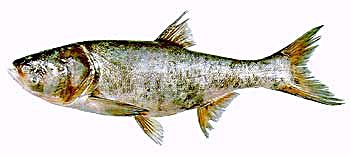 The bighead carp is a freshwater fish, one of several Asian carps. It has a large, scaleless head, a large mouth, and eyes located very low on the head. They are primarily filter-feeders that feed on zooplankton, phytoplankton, and detritus. Bighead carp are native to Eastern Asia and has been introduced to numerous countries worldwide due to its value as food.
The bighead carp is a freshwater fish, one of several Asian carps. It has a large, scaleless head, a large mouth, and eyes located very low on the head. They are primarily filter-feeders that feed on zooplankton, phytoplankton, and detritus. Bighead carp are native to Eastern Asia and has been introduced to numerous countries worldwide due to its value as food.
Why bighead carp?
- Grows fast, reaching 2-4 kg in 4-6 months
- Used as raw material in value-added fish products
- Can be polycultured with other carp species, tilapia, milkfish, catfish, etc.
How to culture Bighead Carp:
Breeding method
- Broodstock are reared in earthen ponds or lake cages until 2 years of age (2-3 kg weight.)
- A soft, swollen belly indicates that eggs have ovulated and a female breeder may be stripped.
- Strip breeders separately by applying gentle massage on the abdomen to release the eggs and milt into a basin.
- Milt is quickly poured on the eggs and mixed in a circular motion with a chicken feather. Saline water is added to keep sperm motile longer.
- Eggs are washed several times with “hard” incubation water (300 to 500 ppm CaCO3) and placed in a hatching tank at a stocking rate of 1,000/liter and provided with good water flow.
- Eggs hatch after 18 to 24 hours. Fresh tap water is introduced gradually every 6 hours post-incubation so that water will have been totally replaced when hatching is complete.
- Larvae are kept in the tank until the yolk sac has been absorbed.
Larval Rearing
- Larvae are harvested from the incubators 4-5 days after hatching and stocked in nursery tanks or large basins with mild aeration at 20-30 individuals per liter.
- Homogenized hard-boiled chicken egg yolk may be fed as long as the particles size is small enough for the fish to eat. Brachionus may be fed until days 6-7. Artemia thoroughly washed in fresh water may also be given on the 5th or 6th day of rearing. Moina may be given after Artemia until the end of the 2-week larval rearing period.
Grow-out Production
- Culture system: Bighead carp are usually grown in lake pens together with tilapia or milkfish.
- Stocking rate: 0.5-1.0 individuals/m2.
- Feeding: Adults feed on phyto- and zooplankton naturally present in the lake
- Average daily weight gain: 7.1 to 10 g (no feeding)
- Culture period: 4 to 6 months
Technical assumptions:
- Project duration : 5 yrs
- Total area of fish pen : 5 ha
- Stocking density : 1/sq.m.
- Crops per year : 2
- Ave. weight at harvest : 1.5 kgs
- Total number of stock/crop : 50,000 pcs
- Percent recovery at harvest : 75%
- Total recovery at harvest : 37,500 pcs
- Total weight of fish at harvest : 56,250 kg
- Farm gate selling price : P 18.00
- Gross sales per cropping : P 1,012,500
Cost and return analysis (Php): Per cropping | Per year
- Gross sales 1,012,500 | 2,025,000
- Variable costs 283,400 | 566,800
- Fixed costs 226,488 | 452,976
- Total cost 509,888 | 1,019,776
Economic Indicators (per year)
- Net income : P 1,005,224
- Income after tax : P 750,948
- ROI : 166 %
- Payback period : 0.49 yrs
- Break-even price : P 9.06
- Break even production : 28,327 kg/crop
- Total capital investment required : P 1,170,800
For more information, contact:
Southeast Asian Fisheries Development Center (SEAFDEC) – Aquaculture Department
Brgy. Buyu-an, Tigbauan,
Iloilo City, Philippines
Landline: (033) 330-7000
Email: [email protected]
Facebook Page: www.facebook.com/seafdec.aqd
Visit Website (This link will open on a new window)